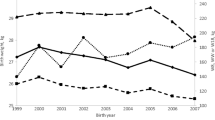Summary
Data from 1,456 purebred Mashona calves were analysed to determine environmental influences on growth rate and liveweight at birth, weaning (205 days) and 18 months of age. Calves were born between mid-September and mid-December each year. Year of birth was highly significant for all traits (P<0.001). Pre-weaning liveweight and weight gain increased as age of dam increased to seven years after which growth tended to decline. Post-weaning compensatory growth was apparent in calves of young dams. Male calves grew faster and were heavier at all stages than female calves (P<0.001). Calves from previously non-lactating cows grew more rapidly and were heavier at all ages than those from previously lactating cows. Birth weight increased as calving season advanced and calves born late maintained their growth advantage until 18 months of age. The results indicate that environmental influences experienced in early life persist long after weaning.
Résumé
Les données de 1456 veaux purs Mashona furent analysées pour déterminer les influences du milieu sur le taux de croissance et le poids vif à la naissance, au sevrage (205) jours et à 18 mois. Les veaux étaient nés entre mi-septembre et mi-décembre chaque année. L'année de naissance était hautement significative pour tous les caractères (P<0,001). Le poids vif avant sevrage et le gain de poids augmentaient avant l'âge de la mère jusqu'à 7 ans, âge aprés lequel la croissance tendait à diminuer. La croissance compensatrice post sevrage était apparente chez les veaux issus de jeunes mères. Les veaux mâles croissaient plus vite et étaient plus lourds à tous les stades que less veaux femelles (P<0,001). Les veaux issus de vaches non allaitantes au préalable, croissaient plus rapidement et étaient plus lourds à tous les âges que ceux des vaches allaitantes au préalable. Le poids à la naissance augmentait tant que la saison de vêlage avançait et les veaux nés tardivement maintenaient leur avantage de croissance jusqu'à 18 mois. Les résultats indiquent que les influences du milieu subies dans la vie précoce persistent longtemps après le sevrage.
Resumen
Se analizaron datos provenientes de 1,456 terneros Mashona puros, para determinar las influencias ambiantes sobre la tasa de crecimiento y peso corporal al nacimiento, destete a los 205 días y a los 18 meses de vida. Los animales nacieron entre mediados de septiembre y mediados de diciembre, cada año. El año de nacimiento fue altamente significativo (P<0.001), para todos los rasgos analizados. El peso (predestete) y la ganancia de peso, se incrementaron en la medida que la edad de las madres aumentaba hasta los siete años, después de los cuales las variables estudiadas decrecieron. El crecimiento compensatorio posdestete fue aparente en terneros de madres jovenes. Los terneros machos crecieron más rápido y fueron más pesados en todo momento, que las hembras (P<0.001). Los terneros provenientes de madres sin lactancia previa, crecieron más rápido y fueron más pesados en todo memento, que aquellos nacidos de madres con lactancia previa. El peso al nacer se incrementó, al avanzar la época de parición y aquellos que nacieron más tarde, mantuvieron las ventajas de crecimiento hasta los 18 meses de edad. Los resultados indican, que las influencias ambientales experimentadas durante el desarrollo temprano, persisten mucho después del destete.
Similar content being viewed by others
References
Flower, A. E., Brinks, J. S., Urick, J. J. &Wilson, F. S. (1963).Journal of Animal Science,22, 914–918.
Harvey, W. R. (1977). User's Guide for Least-squares and Maximum Likelihood Computer Program. Ohio State University, Columbus.
Lobo, R. B., Duarte, F. A. M., Gonçalves, A. A. M., Oliveira, J. A. &Wilcox, C. J. (1984).Animal Production,39, 157–163.
Richardson, F. D., Oliver, J. &Clarke, G. P. Y. (1979).Animal Production,38, 199–211.
Steenkamp, J. D. G. &Pretorius, A. S. (1976). Genotype × environment interaction in beef cattle. Annual Report, 1974/75. Division of Livestock and Pastures. Department of Research and Specialist Services, Salisbury (Harare). pp 3–5.
Tawonezvi, H. P. R., Brownlee, J. W. I. &Ward, H. K. (1986a).Zimbabwe Journal of Agricultural Research,25, (in press).
Tawonezvi, H. P. R., Dhliwayo, H. H., Sibanda, D. &Dube, I. A. (1986b).Zimbabwe Agricultural Journal,83, (in press).
Thorpe, W., Cruickshank, D. K. R. &Thompson, R. (1981).Animal Production,33, 165–177.
Vorster, T. H. (1964). Factors influencing the growth, production and reproduction of different breeds of beef cattle under range conditions in Southern Rhodesia. Research Bulletin of the Southern Rhodesia Department of Agriculture, No. 1.
Ward, H. K. (1968).Rhodesian Journal of Agricultural Research,6, 93–101.
Ward, H. K. &Tiffin, J. de W. (1975).Rhodesian Agricultural Journal,72, 1–7.
Ziswa, L. C. (1986).Zimbabwe Agricultural Journal,83, (in press).
Author information
Authors and Affiliations
Rights and permissions
About this article
Cite this article
Tawonezvi, H.P.R. Growth of mashona cattle on range in Zimbabwe. I. Environmental influences on liveweight and weight gain. Trop Anim Health Prod 21, 37–42 (1989). https://doi.org/10.1007/BF02297340
Accepted:
Issue Date:
DOI: https://doi.org/10.1007/BF02297340




